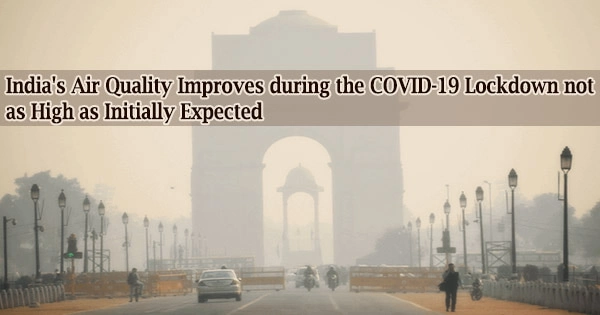According to observational data, air pollution in India significantly decreased during the first COVID-19 lockdown as vehicle emissions naturally decreased. However, York University researchers say that data only tells part of the story because clear skies and the absence of smog can be deceiving and conceal pollutants that could potentially have a negative impact on health.
Looking just at observational data, as many recent studies have done without taking meteorology into account, skews the numbers. Air pollution is the result of a complex mix of interactions between emissions, meteorological, such as wind direction and rain, and chemistry.
The researchers discovered that some air pollutants didn’t decline as much as they had initially predicted, and even more unexpectedly, ozone levels rose even as other pollutants did. Although the air appeared to be much cleaner, this also enabled more sunlight to enter, which led to conditions that permitted ozone (O3) to rise by up to 30%.
“To accurately quantify the impact of the COVID-19 lockdown on air pollutant levels, meteorology and atmospheric chemistry need to be considered in addition to emissions,” says York University postdoctoral researcher Leigh Crilley, who led the Faculty of Science research along with York Associate Professor Cora Young and team.
“Our research shows the decline in local emissions had less influence on the decrease in air pollutants than first thought.”
The researchers had the chance to examine the role of regional sources of air pollutants under typical meteorological conditions because the national shutdown in India eliminated key urban sources of air pollution, like traffic, industry, and construction.
To accurately quantify the impact of the COVID-19 lockdown on air pollutant levels, meteorology and atmospheric chemistry need to be considered in addition to emissions. Our research shows the decline in local emissions had less influence on the decrease in air pollutants than first thought.
Leigh Crilley
Crilley and Young concentrated their research on three air pollutants nitrogen oxides (NOx), fine particulate matter (PM2.5), and ozone as well as the weather conditions at various locations within the Indian cities of Delhi and Hyderabad from March 24 to April 24, 2020, the start of the first lockdown.
A known health danger is air pollution, and India has some of the worst air pollutions in the world, which leads to a disproportionately high rate of mortality and disease. According to estimates, 1.27 million individuals passed away in 2017 as a result of exposure to air pollution, particularly PM2.5.
Additionally, Indian cities have some of the highest levels of O3 in the world. This gas can be produced by a variety of sources and chemistries, either limited by NOx or by volatile organic compounds (VOCs).
The researchers examined hourly meteorological and visibility data as well as hourly data on PM2.5, NOx, and O3 levels from air quality monitoring sites. To assess changes brought on by the lockdown, they compared that data to the same dates from the prior three years. The impact of meteorology on observed levels was taken into account using a boosted regression tree model.
When only observational data were included, NOx and PM2.5 decreased by up to 57% and 75%, respectively. However, when meteorology was taken into consideration, these percentages decreased to less than 8% for PM2.5 and between 5 and 30% in both cities, although O3 increased.
They discovered that weather conditions and atmospheric chemical processes contributed independently to air pollutant levels, while local sources of emissions, such as cars and fuel burning, had less of an impact on pollution levels than regional sources.
“We demonstrate that regional sources, such as rural and agriculturally based emissions, that may have been less affected by the lockdown, have a significant influence on PM2.5 levels in Delhi and Hyderabad after weather-normalization. This indicates that future PM2.5 mitigation strategies should focus on national-scale, as well as local sources,” says Young.
“Overall, this study highlights the impact of emissions, meteorology, and chemistry on air pollution and that all three should be considered when assessing the effects of any short-term intervention on air pollutants.”
The research team also discovered that Delhi’s ozone generation is probably VOC-limited, meaning that efforts to reduce it should concentrate on the main sources of VOCs.
According to the researchers, this clearly illustrates the need for regulators to comprehend the many aspects that contribute to air pollution if they are to develop laws to lessen contaminants and ozone.
















